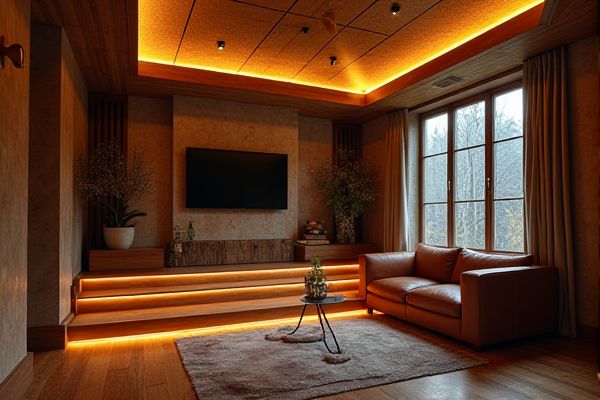
Rope lighting provides continuous, flexible illumination ideal for outlining spaces or adding ambient glow, while spot lighting delivers focused, intense beams perfect for highlighting specific features or tasks. Discover how to choose the right lighting solution for your needs by reading the rest of the article.
Table of Comparison
| Feature | Rope Lighting | Spot Lighting |
|---|---|---|
| Purpose | Decorative, accent, ambient lighting | Focused illumination, highlighting objects or areas |
| Light Distribution | Continuous, even glow along the length | Directional, concentrated beam |
| Installation | Flexible, easy to install along edges or contours | Fixed position, requires mounting and aiming |
| Energy Efficiency | Typically low wattage, LED options available | Varies; LED spotlights offer high efficiency |
| Use Cases | Pathways, under cabinets, accent walls | Artwork, architectural features, task lighting |
| Aesthetic Impact | Soft, ambient glow enhancing mood | Sharp, defined highlights emphasizing details |
| Cost | Generally lower cost, flexible length options | Moderate to high cost depending on quality and features |
| Durability | Durable, weather-resistant models available | Robust, often weatherproof for outdoor use |
Introduction to Rope Lighting and Spot Lighting
Rope lighting consists of flexible tubes housing LED or incandescent bulbs, ideal for accentuating architectural features and creating ambient moods in residential and commercial spaces. Spot lighting uses focused beams from LED or halogen bulbs to highlight specific objects or areas, offering precise illumination for artwork, retail displays, or task lighting. Both lighting types enhance spatial design but serve distinct functions based on diffusion, intensity, and placement.
How Rope Lighting Works
Rope lighting consists of small LED bulbs encased in a flexible, transparent tube that emits continuous, even illumination along its length. The circuitry inside the rope allows electricity to flow through each LED, producing light that is ideal for accentuating architectural features or creating ambient effects. Unlike spot lighting, which directs focused beams to specific areas, rope lighting provides consistent, diffuse glow suitable for outlining spaces or highlighting edges.
How Spot Lighting Functions
Spot lighting functions by directing a focused beam of light onto specific areas or objects, creating sharp contrasts and highlighting details with precision. It uses adjustable fixtures and narrow beam angles to control the intensity and direction of illumination, making it ideal for accentuating artwork, architectural features, or task areas. This targeted approach enhances depth and dimension in spaces, providing both functional and aesthetic benefits.
Design Flexibility: Rope Lighting vs Spot Lighting
Rope lighting offers superior design flexibility due to its continuous, bendable form, allowing seamless installation along curves, edges, and irregular surfaces for ambient or accent lighting. Spot lighting provides focused illumination with adjustable angles but is limited to fixed points, making it ideal for highlighting specific areas or objects. The choice between rope lighting and spot lighting depends on the desired lighting effect and spatial configuration, with rope lighting excelling in broad, uniform glow and spot lighting excelling in directed, high-intensity accents.
Installation Process Comparison
Rope lighting offers a flexible and straightforward installation process, often requiring minimal tools and allowing you to easily contour the light around edges or architectural features. Spot lighting installation typically demands more precision, involving mounting brackets and electrical wiring to position focused beams accurately. Choosing between the two depends on whether your priority is quick installation and ambient lighting or targeted illumination with a more technical setup.
Energy Efficiency and Cost Analysis
Rope lighting consumes significantly less energy compared to spot lighting, typically operating at 7-15 watts per meter versus spotlights that range from 20 to 50 watts per bulb. The initial investment for rope lighting tends to be lower due to simpler installation and fewer components, while spot lighting can incur higher costs from specialized fixtures and increased maintenance. Over time, rope lighting often proves more cost-effective due to reduced electricity usage and longer lifespan, making it an ideal choice for ambient or decorative illumination with budget-conscious energy goals.
Light Quality and Ambiance Differences
Rope lighting emits a continuous, diffused glow ideal for creating soft, ambient illumination, while spot lighting delivers focused, intense beams that highlight specific areas or objects. The warm, even light of rope lighting enhances mood and accentuates architectural lines, whereas spot lighting provides clear visibility and sharp contrasts, emphasizing textures and details. Choosing between the two depends on whether the goal is to establish a relaxed atmosphere or to draw attention with precise lighting effects.
Ideal Applications for Rope Lighting
Rope lighting is ideal for creating continuous, flexible lines of light along architectural features like staircases, pathways, and under cabinets, providing ambient illumination and enhancing safety. Its adaptability in indoor and outdoor settings makes it perfect for accent lighting in residential or commercial spaces, highlighting contours and adding a decorative glow. Unlike spot lighting, which targets specific areas, rope lighting offers evenly distributed light that can transform your environment with subtle yet effective brightness.
Ideal Uses for Spot Lighting
Spot lighting is ideal for highlighting specific areas or objects such as artwork, architectural features, or focal points in a room, providing focused and intense illumination. It excels in creating dramatic effects and enhancing visual interest in both residential and commercial spaces. Your choice of spot lighting allows precise control over light direction and intensity, making it perfect for task lighting or accentuating decor details.
Choosing Between Rope Lighting and Spot Lighting
Rope lighting offers continuous, flexible illumination ideal for outlining spaces and creating ambient effects, while spot lighting provides focused, directional beams suited for highlighting specific objects or areas. Your decision should consider whether you need broad, subtle glow or intense, concentrated light to enhance functionality and aesthetics. Factors like installation complexity, energy consumption, and intended atmosphere play key roles in choosing between rope lighting and spot lighting.
 homyna.com
homyna.com